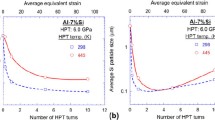Abstract
A law governing the change in the ductility of metals and alloys under pressure is given:
where P is the hydrostatic pressure, ɛlocal is the strain accumulated from the start of necking to fracture, σ n necking stress and (dσ/dɛ) the coefficient of linear work hardening. This relation is derived from a newly proposed criterion of ductile fracture, viz. “constancy of hydrostatic tensile stress”, which indicates that the change of ductility with pressure obeys a three halves power law. The observed increase in ductility of widely differing metals and alloys under pressure up to 10,000 kg/cm4 has confirmed that the proposed criterion is acceptable.
It is further shown that the ductilities of some copper alloys with low stacking fault energy, such as Cu-Zn and Cu-Ge alloys, increases with pressure at the beginning but the increase stops at fairly low pressure, i.e. 3,500 ∼ 4,000 kg/cm2, and their ductilities become almost insensitive to the pressure applied. It is suggested that ductile fracture of metals with low stacking fault energy is dominated by a process which occurs not by the hydrostatic stress component but by shear stress only.
Résumé
On établit une relation exprimant l'évolution de la ductilité des métaux et alliages en fonction de la pression hydrostatique. Dans l'expression:
P désigne la pression hydrostatique, ɛlocale la déformation accumulée entre le debut de la striction et la rupture, σ n la contrainte de striction et dσ-/dɛ le coefficient d'écrouissage linéaire.
Cette relation est établie en se basant sur un nouveau critère de la rupture ductile, à savoir la constance des tensions hydrostatiques, qui rend compte que l'évolution de la ductilité avec la pression hydrostatique obéit à une loi de puissance trois demi. L'accroissement de ductilité que l'on a observé sur des métaux et alliages de caractéristiques très diffèrentes soumis à des pressions allant jusqu'à 10.000 kg/mm2, confirme la pertinence du critère proposé. On montre également que la ductilité de certains alliages de cuivre á faible énergie de défauts d'empilement-tels que les alliages Cu-Zn et Cu-Ge-augmente an début de la mise sous pression, mais que, á partir de pressions relativement basses, à savoir 3500 à 4000 kg/cm2, l'accroissement cesse de se manifester, et la ductilité demeure sensiblement indépendante de la pression. Pour expliquer ce comportement des alliages á faible énergie d'empilement, on suggère que la rupture ductile de ces métaux résulte d'un processus où n'interviennent pas les composantes de contraintes hydrostatique, mais uniquement les contraintes de cisaillement.
Zusammenfassung
Es wird eine Formel aufgestellt, welche den Verlauf der Verformbarkeit von Metallen und Legierungen in Abhängigkeit des hydrostatischen Druckes angebt.
In der Gleichung:
Bruch, σn die Einschnurungsspannung und dσ/dn den Koeffizienten der linearen Verformungshartnung. Diese Abhängigkeit wurde abgeleitet auf Grund einer neuen Kenngröße des Dehnbruchverhaltens, nähmlich der Konstanz der hydrostatischen Spannungen, welche angibt, daß der Verlauf der Dehnbarkeit mit dem hydrostatischen Druck einem Gesetz der Potenz drei halbe folgt. Der Anstieg der Verformbarkeit unter Drücken bis zu 10000 kg/cm2 welcher für zahlreiche Metalle and Legierungen mit sehr unterschiedlichen Eigenschaften beobachtet wurde bestätigt die Aussagekraft des vorgeschlagenen Kennwertes.
Es wird ferner gezeigt, daß die Verformbarkeit verschiedenen Legierungen mit geringer Fehlbaustellenenergie-wie z.B. die Legierungen Cu-Zn and Cu-Ge-sich zuerst mit steigendem Druck erhöht, daß dann ober schon ob relative niedrigen Drucken d.h.: bei 3500–4000 kg/cm2 ein weiterer Ausbieg der Verformbarkeit nicht mehr auftritt und dieselbe annahernd konstant bleibt and dies unabhängig von dem aufgegebenen Druck. Um dieses Verhalten der Legierungen mit geringer Fehlbaustellenenergie zu erklären wird vermutet, daß der Verformungsbruch dieser Metalle durch einen Vorgang hervorgerufen wird bei dem die Komponenten der hydrostatischen Spannung nicht beteiligt sind sondern nur die Scherspannungen wirken.
Similar content being viewed by others
References
P. W. Bridgman, Large Plastic Flow and Fracture, McGraw-Hill Book Company, Inc., 1952.
B. I. Beresnev, L. F. Vereshchagin, Yu. N. Ryabinin and L. D. Livshits, Some Problems of Large Plastic Deformation at High Pressures, Pergamon Press, 1963.
H. Ll. D. Pugh and D. Green, Proc. Instn. Mech. Engrs., 179 (1964–65) 415.
A. Bobrowsky, ASME Paper, 64-WA/PT-29,1964.
M. Nishihare, K. Tanaka and T. Muramatsu, Proc. 8th Japan Congr. Test. Mater., 8 (1965) 73.
T. E. Davidson, J. C. Uy and A. P. Lee, Acta Met., 14 (1966) 937.
M. Yajima and M. Ishii, J. of Japan Soc. for Technology and Plasticity, 9 (1968) 405.
I. G. Palmer, G. C. Smith and R. D. Warda, Conference Proc., Physical Basis of Yield and Fracture, London (1966) 53.
J. Gurland and J. Plateau, Trans. A.S.M., 56 (1963) 442.
H. C. Rogers, Trans. Met. Soc. A.I.M.E., 218 (1960) 498.
K. E. Puttick, Phil. Mag., 4 (1959) 964.
J. Gurland, Trans. Met. Soc. A.I.M.E., 227 (1963) 1146.
M. F. Ashby, Phil. Mag., 14 (1966) 1157.
F. A. McClintock, S. M. Kaplan and C. A. Berg, Inter. J. Fracture Mechanics, 2 (1966) 614.
K. Takase, Proc. 1st Inter. Conf on Fracture, vol. 3, (1965) p. 1837 Sendai, Japan.
V. L. Kolmogorov and V. F. Shishmintsev, Fiz. metal. metalloved., 21 (1966) 910.
N. N. Davidenkov and N. I. Spiridionova, Proc. A.S.T.M., 46 (1946) 1147.
H. Ll. D. Pugh, National Engineering Laboratory Report, No. 142, 1964, England.
H. Kudo, K. Sato and I. Sawano, J. of Japan Soc. for Technology and Plasticity, 6 (1965) 499.
S. Takahashi, J. of Japan Soc. for Technology and Plasticity, in press.
T. A. Trezera, Trans. A.S.M. 56 (1963) 780.
Yu. N. Ryabinin, Inzhener. Fiz. Zhur., 1 (1958) 90.
A. Howie and P. R. Swann, Phil. Mag., 6 (1961) 1215.
P. R. Thornton, T. E. Mitchell and P. B. Hirsch, Phil. May., 7 (1962) 1349.
Author information
Authors and Affiliations
Rights and permissions
About this article
Cite this article
Yajima, M., Ishii, M. & Kobayashi, M. The effects of hydrostatic pressure on the ductility of metals and alloys. Int J Fract 6, 139–150 (1970). https://doi.org/10.1007/BF00189821
Received:
Issue Date:
DOI: https://doi.org/10.1007/BF00189821




